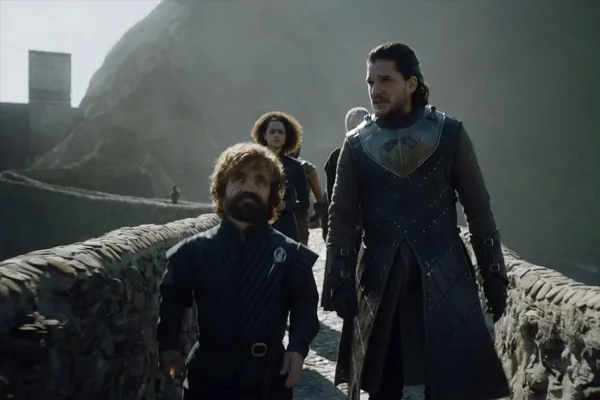For Medieval Scholars, “Game of Thrones” is Bittersweet
"Don’t get me started on people who see all the sexual assault on the show and try to argue, 'That’s just the way things were for women back then.' Back when? When was there a Westeros?"
For this piece I wrote for CFR last year, I spoke with medievalist Kelly Williams, a close friend of mine, on the impact Game of Thrones has had on the field of medieval studies. Not surprisingly, it's a mixed bag, with the show both increasing students' interest in the Middle Ages, while also distorting a lot of their understanding of real history. It was a really fun interview, so I've reposted part of it to this blog, and you can read the full version after the link.
---
Tyrion Lannister (Peter Dinklage, left) and Jon Snow (Kit Harrington) on Game of Thrones (Photo: HBO)
Does Game of Thrones come up in your classes? How has it shaped your students’ understanding of the Middle Ages?
Definitely! The show has been most helpful in making European medieval concepts more familiar so that when students encounter something for the first time, they feel like they already have a point of reference. For example, I’ve used Cersei Lannister and Sansa Stark to explain the concept of the Anglo-Saxon peaceweaver (a woman given in marriage to cement alliances between opposing groups), and I’ve used characters like Jon Snow, Loras Tyrell and Ned Stark – “flowers of chivalry and virtue” – to explain how codes of honor were ideals that didn’t necessarily work out in real life. Daenerys’s dragons have also made students react more positively toward fantastical elements in medieval literature, and a number of them have written smart and articulate papers on how these elements reflect a particular society’s values. I’ve also seen students become enraptured by the connections between Game of Thrones and the real-life events that George R. R. Martin drew on to write his novels. Some of them have even tried to use the show to understand the complexity of the Wars of the Roses. I personally haven’t been able to fully understand that history myself, so I admire those students for trying.
I also love seeing students use the show to check their own assumptions. For example, I guest-taught the episode “Mhysa” last semester and pointed out the scene where Daenerys, having just freed the slaves of Yunkai (or inspired them to free themselves, based on interpretation), is surrounded by a sea of brown-skinned people. Some students admitted that they hadn’t thought about representations of people of color on the show until I pointed out the race dynamics in this episode, and we had a very productive discussion about how media that portrays the Middle Ages (and fantasy based on the middle ages) tends to focus on European history and exclude people of color in the name of “historical accuracy.” Some students even pointed out other shows where people of color were only portrayed as slaves or members of “uncivilized” nomadic tribes and remarked upon how they reinforced conscious or unconscious racism in modern culture.
I was frustrated by some students’ refusal to see the female characters as anything other than prefigurations of Cersei Lannister
On the flip side, however, I’ve also encountered a surprising amount of resistance on certain topics – particularly the interpretation of women. Some students have the tendency to reduce medieval women to three main character types: the passive, powerless victim; the badass warrior queen; or the scheming, power-hungry villainess. I remember more than one class where I was teaching some of Marie de France’s poetry and was particularly frustrated by some students’ refusal to see the female characters as anything other than prefigurations of Cersei Lannister (despite the text praising the women for their virtue). Granted, I don’t think that students have to agree with me, or that these analyses have been solely due to Game of Thrones, but the show is the most common analogy that students use when they describe their interpretation of a female character. And don’t get me started on people who see all the sexual assault on the show and try to argue, “That’s just the way things were for women back then.” Back when? When was there a Westeros?
(For the full article, you can read more here.)

